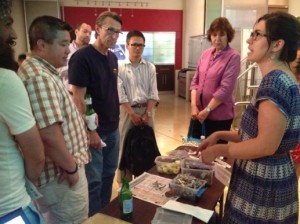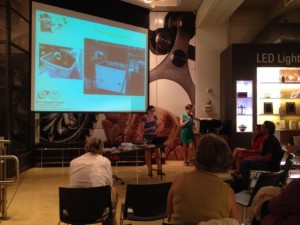 n July 16th, compost novices and experts alike gathered at the Hafele America showroom for a workshop on in-home composting led by Celeste McMickle, a Master Composter certified by the NYC Compost Project. The GreenHomeNYC audience had the chance to learn key strategies on making the most out of their food and yard waste and best practices for putting the nutritious end-products to use.
In New York City, where organics make up nearly a third of the city’s residential and institutional waste stream, there is a multitude of ways to divert these materials from landfills. A NYC Organics Collection pilot program launched by the Department of Sanitation in 2012 provides curbside pickup for select neighborhoods in the outer boroughs. However, for those not living in the pilot zones, plenty of options exist such as multiple drop-off locations at local Greenmarkets and collection sites at neighborhood community gardens. Seasonal events like mulch fests and collection sites at the Brooklyn Botanic Garden and the Lower East Side Ecology Center provide year-round opportunities to put yard and food wastes to good use. For a full list of food scrap drop-off sites and acceptable materials, visit the Bureau of Waste Prevention’s web site.
For those audience members interested in making their own compost, Celeste shared some important guidelines: have the right kind of bin and keep an even proportion of moist nitrogen-rich greens (ex. fruit and vegetable scraps, coffee) and dry carbon-rich browns (ex. soil, shredded newspaper) in your mixture. Depending on where your compost bin is located and how much volume it will have to accommodate, different bin solutions exist. If it will be housed in a larger space such as a backyard or community garden, you can make special compost bins out of wooden pallets or hardwood, but if composting on a smaller scale, then opt for a store-bought option such as a Garden Gourmet or Earth Machine. It is important to keep in mind the need for a
n July 16th, compost novices and experts alike gathered at the Hafele America showroom for a workshop on in-home composting led by Celeste McMickle, a Master Composter certified by the NYC Compost Project. The GreenHomeNYC audience had the chance to learn key strategies on making the most out of their food and yard waste and best practices for putting the nutritious end-products to use.
In New York City, where organics make up nearly a third of the city’s residential and institutional waste stream, there is a multitude of ways to divert these materials from landfills. A NYC Organics Collection pilot program launched by the Department of Sanitation in 2012 provides curbside pickup for select neighborhoods in the outer boroughs. However, for those not living in the pilot zones, plenty of options exist such as multiple drop-off locations at local Greenmarkets and collection sites at neighborhood community gardens. Seasonal events like mulch fests and collection sites at the Brooklyn Botanic Garden and the Lower East Side Ecology Center provide year-round opportunities to put yard and food wastes to good use. For a full list of food scrap drop-off sites and acceptable materials, visit the Bureau of Waste Prevention’s web site.
For those audience members interested in making their own compost, Celeste shared some important guidelines: have the right kind of bin and keep an even proportion of moist nitrogen-rich greens (ex. fruit and vegetable scraps, coffee) and dry carbon-rich browns (ex. soil, shredded newspaper) in your mixture. Depending on where your compost bin is located and how much volume it will have to accommodate, different bin solutions exist. If it will be housed in a larger space such as a backyard or community garden, you can make special compost bins out of wooden pallets or hardwood, but if composting on a smaller scale, then opt for a store-bought option such as a Garden Gourmet or Earth Machine. It is important to keep in mind the need for a eration while simultaneously keeping away pests such as rats and pigeons while composting in an urban environment.
Another option for smaller and indoor spaces is vermicomposting, or using worms in a bin to efficiently process organic materials into compost. While considering this option, note that the red wiggler worms eat about half their weight in food scraps a day and need to be continuously fed in order to survive, also their diet is a little bit more restricted than a typical compost bin, so research in advance about what they can and cannot eat (hint: skip the citrus.) The presentation concluded with a hands-on opportunity for a volunteer to create worm bedding and time for the informed audience to ask questions.
eration while simultaneously keeping away pests such as rats and pigeons while composting in an urban environment.
Another option for smaller and indoor spaces is vermicomposting, or using worms in a bin to efficiently process organic materials into compost. While considering this option, note that the red wiggler worms eat about half their weight in food scraps a day and need to be continuously fed in order to survive, also their diet is a little bit more restricted than a typical compost bin, so research in advance about what they can and cannot eat (hint: skip the citrus.) The presentation concluded with a hands-on opportunity for a volunteer to create worm bedding and time for the informed audience to ask questions.

Leave a Reply
You must be logged in to post a comment.